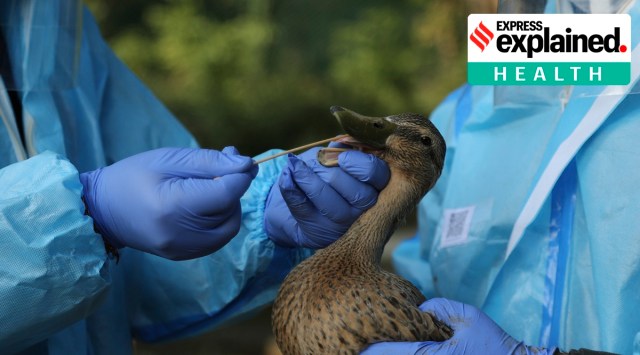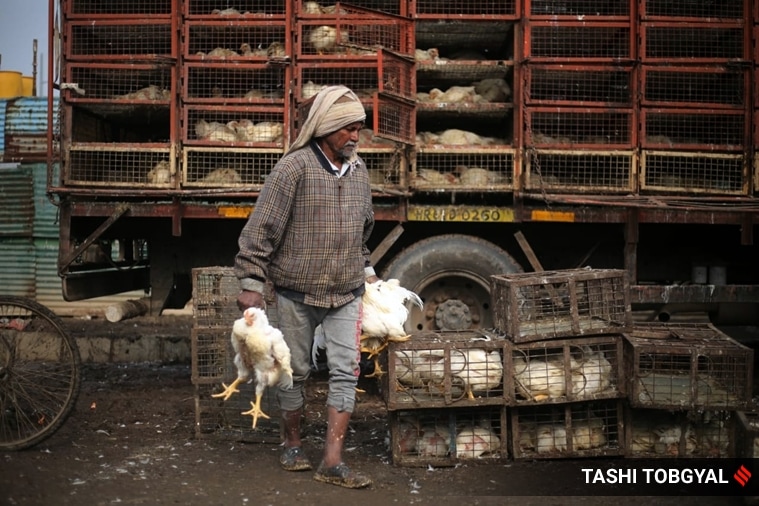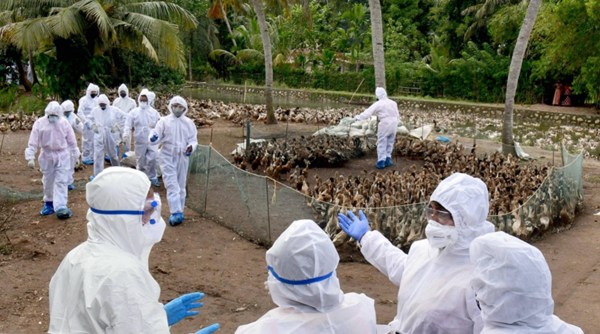- India
- International
Explained: Why there is fear and anxiety over the return of bird flu
With the novel coronavirus still rampant, fear of a new virus, which causes bird flu, has spread. This virus does not normally spread from human to human — however, earlier outbreaks caused considerable losses to the poultry industry. Several states have reported deaths of birds, but mostly non-domesticated.
 A wildlife department doctor collects a swab from a duck at Manda park in Jammu on Thursday. Several states and UTs have sounded a bird flu alert. (AP Photo)
A wildlife department doctor collects a swab from a duck at Manda park in Jammu on Thursday. Several states and UTs have sounded a bird flu alert. (AP Photo)After bird flu (avian influenza) was confirmed in Kerala, Rajasthan, Madhya Pradesh, Haryana, and Himachal Pradesh, high alert has been sounded in Maharashtra. Several states, which have been reporting deaths of birds, including crows and migratory species, are scrambling to have samples tested for the virus.
As anxiety spreads, there is fear of a fresh blow to the poultry industry — reports have been coming in of people giving up chicken and eggs, and of prices falling.
The infection
Bird flu or avian influenza is the name used to describe a viral infection that is reported mostly in birds, but has the potential to affect humans and other animals. The most common strain of the virus that causes severe respiratory disease in birds is H5N1; various other strains like H7, H8 too, cause infection.
The virus was first reported in geese in China in 1996. Since then, outbreaks have been reported periodically across the world. India reported the presence of the virus in Nandurbar, Maharashtra, in 2006, which led to large-scale culling of poultry birds.
Samples from Rajasthan, Madhya Pradesh, and Kerala have tested positive for the A (H5N8) strain of the virus, while samples from Himachal Pradesh have shown the presence of A (H5N1).

 At a Ghazipur poultry mandi. (Express Photo: Tashi Tobgyal)
At a Ghazipur poultry mandi. (Express Photo: Tashi Tobgyal)
Human transmission
The H5N1 virus can jump species and infect humans from the infected bird. The first case of H5N1 infection in humans was reported in Hong Kong in 1997, when a poultry farm worker caught the infection from infected birds.
The high mortality rate in humans — almost 60 per cent — is the main cause of concern about the spread of bird flu. In its present form, human-to-human infection is not known — human infections have been reported only among people who have handled infected birds or carcasses.
How common is it?
Between 2006 and December 31, 2018, India reported 225 epicenters of bird flu infection, which led to the culling of 83.49 lakh birds, with farmers being paid Rs 26.37 crore in compensation.
Interestingly, Maharashtra which was the first state to report the infection, has not seen an outbreak since 2006. Odisha, Tripura, and West Bengal are among the states that have reported repeated outbreaks of the infection in both domesticated and wild birds.
This time, most infections have been reported either in wild birds, crows or migratory birds, Dr A S Ranade, Dean, Bombay Veterinary College, said. Since 2006, the poultry industry has developed bio safety zones around farms, which has stopped commercially reared birds from coming in contact with any foreign feed or bird, Dr Ranade said.
 A team of health experts, from the Union Ministry of Health and Family Welfare, visit a bird flu affected area at Karuvatta in Alappuzha district, Kerala, Thursday, Jan. 7, 2021. (PTI Photo)
A team of health experts, from the Union Ministry of Health and Family Welfare, visit a bird flu affected area at Karuvatta in Alappuzha district, Kerala, Thursday, Jan. 7, 2021. (PTI Photo)
Poultry meat, eggs
Dr Ranade pointed out that the chances of the H5N1 virus infecting humans is comparatively low in India as compared to South East Asian countries, mainly because of the difference in culinary habits.
“The virus dies immediately if exposed to temperatures over 70 degrees Celsius. Unlike in South East Asian countries, both meat and eggs in India are eaten well cooked, which sees them being exposed to over 100 degrees Celsius. Thus the chances of humans contracting the virus from eating chicken and eggs is extremely rare,” he said.
India consumes 30 crore poultry birds and 900 crore eggs per month on average.
At the start of the Covid-19 pandemic, the poultry industry suffered a body blow after unsubstantiated rumours linked the spread of the disease with consumption of chicken and eggs. Within a span of two months, the industry suffered losses of around $ 1 billion, as people kept away from eggs and poultry meat. While the industry has managed to get back on its feet, production remains low.
INCIDENTS ACROSS INDIA
Gujarat: 124 local birds, including 70 crows, and 6 migratory species reported dead
Odisha: 120 poultry birds dead in Khurda district; government says all samples so far have returned negative for bird flu
Uttar Pradesh: At least 10 crows found dead in Sonbhadra district; officials say cold and pollution likely cause; samples sent for testing
Rajasthan: A total 2,166 birds dead up to Friday; including 1,706 crows and 136 peacocks
Chhattisgarh: 4 crows were found dead on Thursday; samples sent for tests. Samples have been picked from seven government poultry farms too
Delhi: Around 20 crows reported dead over the last few days in East Delhi; samples sent for testing
More Explained
EXPRESS OPINION
Apr 16: Latest News
- 01
- 02
- 03
- 04
- 05








































